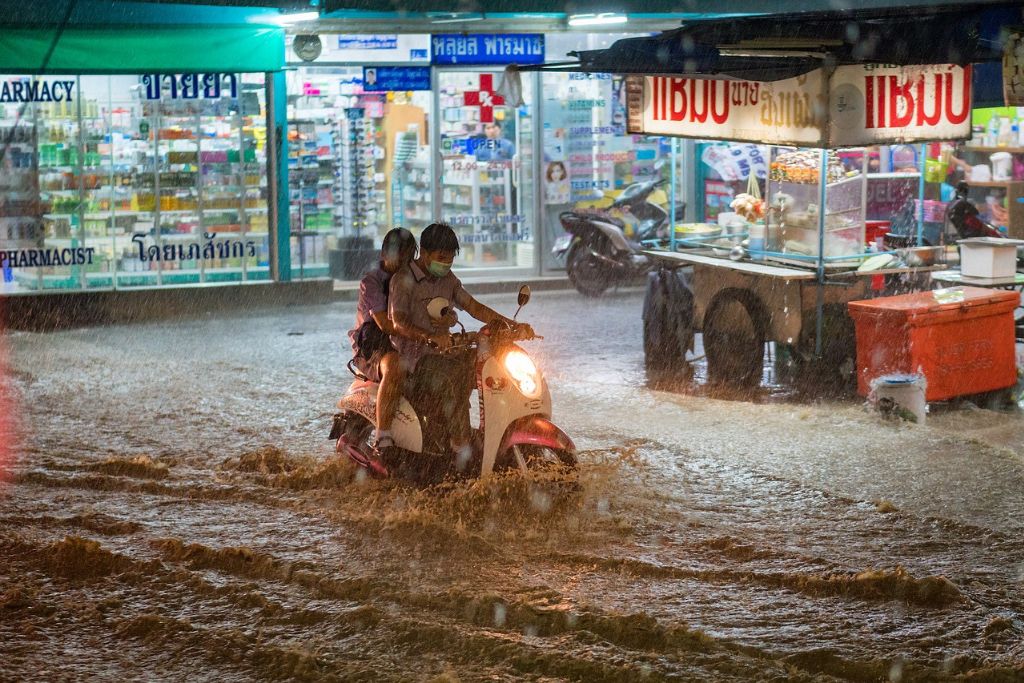Extreme heat in Thailand has killed 30 people so far this year, compared to 37 in 2023. Meanwhile, East Africa has been battling torrential rain over the past month, which triggered floods and landslides that claimed more than 200 lives across Kenya and Tanzania.
—
Climate change-related extreme weather events are wreaking havoc around the world, killing hundreds and displacing thousands of people.
Extreme Heat
Thailand has been battling with extreme heat for days. The country’s northern and northeastern regions are expected to be the warmest until the end of the month, with the mercury hitting 44C in some areas, the Thai Meteorological Department said. Hail and thunderstorms may strike the two regions in the coming days, it added.
On Thursday, authorities in the capital Bangkok issued an extreme heat warning for the sixth consecutive day as the apparent temperature – a measure of how temperature is perceived by humans when humidity is taken into account – rose to 52C (126F). Local authorities prompted people to stay indoors.
On Monday evening, electricity demand reached a record high of 35,380 megawatts, the eight time the record was broken since February 22, the Bangkok Post reported.
The number of heat-related casualties nationwide has reached 30 so far this year, compared to the 37 heat-related deaths recorded in the country in 2023, according to data by the Thai Health Ministry.
Southeast Asian countries are among those most heavily affected by climate change. The frequency and intensity of extreme weather events in the region have been increasing markedly, often leading to the loss of life, homes, and livelihoods and causing severe economic damage.
A report on the state of the climate in Asia published earlier this week by the World Meteorological Organization (WMO) found that 47% of all 984,263 climate and natural disaster-related deaths over the past five decades occurred in Asia, with tropical cyclones claiming the highest number of lives. In 2023 alone, Asia saw a total of 79 water hazard-related disasters, which resulted in more than 2,000 fatalities and directly affected 9 million people.
Temperatures in the continent were 0.91C above the 1991-2020 reference period in 2023, the second-highest on record. A historic heatwave swept across the continent in April and May, bringing all-time high temperatures to Vietnam, Laos, and Thailand. While a period of intense heat is not uncommon before the rainy season kicks in, the intensity of last year’s heatwave, which shattered all previous records, was unprecedented.
More on the topic: ‘Sobering’ WMO Report Shows Asia Hit Hardest By Climate Change in 2023
Torrential Rain
Meanwhile, East Africa has been battling heavy rains for the past month. In hard-hit Kenya, floods have killed 10 people this week, bringing the total death toll since last month to 45. According to Reuters, Kenyan President William Ruto deployed the military on Thursday to help with rescue operations.
The United Nations Office for the Coordination of Humanitarian Affairs (OCHA) said almost 103,500 people have been affected and 40,265 have been displaced in 21 out of the 47 counties of Kenya as of April 19. The UN body said relief efforts led by national authorities with the support from humanitarian parters are helping to deliver assistance to 20,590 people.
The situation is tragic in neighboring Tanzania, too. Here, the death toll from heavy rains has reached 155, with 236 more injured, according to Kaasim Majaliwa, the country’s prime minister. Reporting to parliament on the situation in the country, Majaliwa said a combination of El Niño-fuelled heavy rains and strong winds resulted in floods and landslides that caused significant damage. He warned that the rains might continue into May, urging people to leave flood-prone areas.
Featured image: qimono/Pixabay
This story is funded by readers like you
Our non-profit newsroom provides climate coverage free of charge and advertising. Your one-off or monthly donations play a crucial role in supporting our operations, expanding our reach, and maintaining our editorial independence.
About EO | Mission Statement | Impact & Reach | Write for us


















